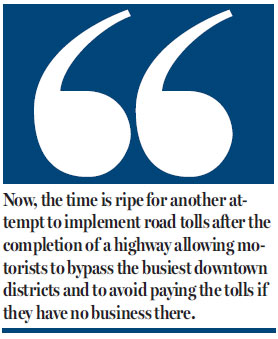A sensible solution to ease traffic congestion in HK
Updated: 2015-12-23 09:17
By Peter Liang(HK Edition)
|
|||||||
Hong Kong is one of the last major cities in the world not to charge motorists for the use of congested roads in the busy commercial districts during rush hours. Two previous attempts in the past to introduce some form of road toll were dropped in the face of stiff resistance from businesses and motorists.
Now, the time is ripe for another attempt after the completion of a highway allowing motorists to bypass the busiest downtown districts and to avoid paying the tolls if they have no business there. The government has initiated a public consultation on the proposal to introduce Electronic Road Pricing (ERP). Its proposal should be supported for obvious reasons.
In recent years, many people have complained about unbearable traffic congestion in commercial districts, particularly Central, Causeway Bay and Wan Chai. The problem is getting worse as the number of vehicles, both private and commercial, is rapidly rising - while the building of new roads is severely constrained by limited space due to Hong Kong's hilly terrain.
Worsening traffic congestion has created an even more serious problem - air pollution - which poses an immediate threat to public health. Although the government has successfully pushed for the use of cleaner fuel in buses and taxis, roadside air quality continues to deteriorate. As most people know, stationary cars stranded in traffic jams with engines running are the worst offenders when it comes to fouling the air.
Of course, traffic congestion is not a new problem. Following the example set by Singapore in the early 1980s, the Hong Kong authorities initiated in 1983 to 1985 a pilot test on an ERP system, reportedly with positive results. But the government had to shelve the proposal in face of stiff public opposition.
In the 1990s, ERP was again put on the agenda as an alternative to the highly controversial proposal to reclaim part of the harbor front for building a key bypass. Reclamation was the choice allowing the government to go ahead with the road bypass project, which is scheduled for completion in early 2016, leaving no more excuses for objecting to the introduction of ERP to solve the worsening traffic congestion in Central district.
There are critics who contend that the Central-Wan Chai bypass will divert part of the traffic from Central and ease the congestion. This is not necessarily the case. The congestion is caused by the rising number of vehicles that take people and goods to and from Central. The bypass is not going to solve this problem.
Experiences in Singapore and some other major world cities have shown that ERP charges must be set high enough to deter commuters from taking their cars to the central business district when they can travel more conveniently and cheaply by public transport. Indeed, all commercial districts along the harbor front from Central to North Point are well served by various modes of public transport, including the MTR, buses, minibuses and trams.
In Hong Kong, traffic on the three cross-harbor tunnels has demonstrated that pricing matters in seeking a more balanced diversion. As charges are not that different for all three, motorists naturally gravitate to the Cross-Harbour Tunnel, resulting in frequent massive traffic congestion on all the feeder roads. Traffic authorities have proposed addressing the problem after ownership of the Eastern Harbour Crossing is transferred to the government after the 30-year lease to a consortium expires in August 2016. It is widely expected that there will be a rate adjustment to divert traffic from the Cross-Harbour Tunnel which is owned and operated by the government.
There is a more cost effective alternative to ERP in traffic control, and that is getting rid of the cars. Some major cities in Europe and the US are designating more and more inner city roads as pedestrian-only zones. The idea is not new to Hong Kong, where certain areas in the commercial districts are cordoned off for pedestrians only. But it is done only on Sundays and public holidays.
A coalition of environmental groups has proposed the creation of a permanent pedestrian zone at the busiest section of a main road in Central to effectively solve the dual problem of traffic congestion and air pollution in that area. This seems like a sound suggestion. It can be adopted irrespective of the final decision made on ERP.
It is solution that the public wants, as the problem is getting out of control.
The author is a veteran current affairs commentator.

(HK Edition 12/23/2015 page9)